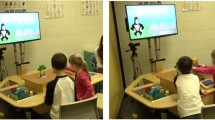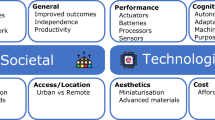Abstract
Ambient assisted living proposes to utilize technological solutions to sustain the well being of elderly people. In accordance with the vision of successful aging, we describe in this study an autonomous robotic exercise tutor for elderly people. The robot learns a set of physical exercises from a human demonstrator in an imitation framework, and performs these motions in an exercise scenario, while monitoring the elderly person to provide verbal feedback. We developed an exercise program in collaboration with a nursing home, and tested our system in a real world scenario with visitors of a day care center, over multiple sessions. We provide a detailed description of the system implementation, as well as our observations for the exercise program. For the study held in the day care center, video annotations and user self-assessments are evaluated to measure the overall performance of the system and to validate our approach. The analysis revealed that elderly people can successfully exercise with the assistance of the robot, while staying engaged with the system over multiple sessions.












Similar content being viewed by others
Notes
This paper extends our earlier work (Görer et al. 2013) with a complete feedback system, increased social capabilities, studies with elderly over multiple sessions, evaluation of communicative behavior, and evaluation of user satisfaction.
This is mostly due to the fact that speech recognition tools in Turkish language are limited, compared to tools developed for English language.
All questionnaires used in this study can be obtained by contacting the corresponding author.
A sample session can be seen at https://youtu.be/lbLo3-oIi8o.
https://tla.mpi.nl/tools/tla-tools/elan/ (Wittenburg et al. 2006).
We did not assess personality formally, in order to keep the setup simpler.
We did not use a formalism for coding facial actions but described the expected expressions from the existing literature. Nevertheless, the annotations show high inter-annotator consistency.
References
Bainbridge, W. A., Hart, J, Kim, E. S. & Scassellati, B. (2008). The effect of presence on human-robot interaction. In: The 17th IEEE International Symposium on Robot and Human Interactive Communication, pp. 701–706.
Barnes, P., Spooner, T., Dhabolt, J., & Leighton, J. (2009). Instructional gaming methods and apparatus. Patent, A1, 20090176581.
Billard, A., Calinon, S., Dillmann, R. & Schaal, S. (2008). Robot programming by demonstration. In: Springer handbook of robotics, Springer, pp. 1371–1394.
Broekens, J., Heerink, M., & Rosendal, H. (2009). Assistive social robots in elderly care: A review. Gerontechnology, 8(2), 94–103.
Brooks, D. A. (2012). Quantifying upper-arm rehabilitation metrics for children through interaction with a humanoid robot. PhD thesis, Georgia Institute of Technology.
Colombo, R., Pisano, F., Mazzone, A., Delconte, C., Micera, S., Carrozza, M., et al. (2007). Design strategies to improve patient motivation during robot-aided rehabilitation. Journal of NeuroEngineering and Rehabilitation, 4(1), 3–12.
Dautenhahn, K., Woods, S., Kaouri, C., Walters, M. L., Koay, K. L. & Werry, I. (2005). What is a robot companion - friend, assistant or butler? In: IEEE/RSJ International Conference on Intelligent Robots and Systems, pp. 1192–1197.
Ezer, N., Fisk, A. D., & Rogers, W. A. (2009a). Attitudinal and intentional acceptance of domestic robots by younger and older adults. In Universal access in human-computer interaction (pp. 39–48). Intelligent and Ubiquitous Interaction Environments: Springer.
Ezer, N., Fisk, A. D., & Rogers, W. A. (2009b). More than a servant: Self-reported willingness of younger and older adults to having a robot perform interactive and critical tasks in the home. In Proceedings of the Human Factors and Ergonomics Society Annual Meeting, SAGE Publications, 53, pp. 136–140.
Fasola, J., & Mataric, M. (2012). Using socially assistive human-robot interaction to motivate physical exercise for older adults. Proceedings of the IEEE, 100(8), 2512–2526.
Fasola, J., & Mataric, M. (2013). A socially assistive robot exercise coach for the elderly. Journal of Human-Robot Interaction, 2(2), 3–32.
Fasola, J., & Matarić, M. J. (2013). A socially assistive robot exercise coach for the elderly. Journal of Human-Robot Interaction, 2(2), 3–32.
Feil-Seifer, D. & Mataric, M. (2005). Defining socially assistive robotics. In: 9th International Conference on Rehabilitation Robotics, ICORR, pp. 465–468.
Feil-Seifer, D., & Mataric, M. (2011). Socially assistive robotics. Robotics Automation Magazine, IEEE, 18(1), 24–31.
Gadde, P., Kharrazi, H., Patel, H., & MacDorman, K. F. (2011). Toward monitoring and increasing exercise adherence in older adults by robotic intervention: A proof of concept study. Journal of Robotics, 1, 1–11.
Giuliani, M., Scopelliti, M., & Fornara, F. (2005). Elderly people at home: technological help in everyday activities. In: IEEE International Workshop on Robot and Human Interactive Communication, IEEE, pp. 365–370.
Görer, B., Salah, A. A. & Akın, H. L. (2013). A robotic fitness coach for the elderly. In: Ambient Intelligence, Springer, pp. 124–139.
Heerink, M. (2010). Assessing acceptance of assistive social robots by aging adults. PhD thesis, University of Amsterdam.
Heerink, M., Kröse, B., Evers, V., Wielinga, B., et al. (2008). The influence of social presence on acceptance of a companion robot by older people. Journal of Physical Agents, 2(2), 33–40.
Hu, K., Ott, C., & Lee, D. (2014). Online human walking imitation in task and joint space based on quadratic programming. In: IEEE International Conference on Robotics and Automation (ICRA), pp. 3458–3464.
Kidd, C. & Breazeal, C. (2004). Effect of a robot on user perceptions. In: IEEE/RSJ International Conference on Intelligent Robots and Systems (IROS), Vol. 4, pp. 3559–3564.
Klamer, T. & Allouch, S. B. (2010). Acceptance and use of a social robot by elderly users in a domestic environment. In: 4th International Conference on Pervasive Computing Technologies for Healthcare, pp. 1–8.
Koenemann, J., Burget, F. & Bennewitz, M. (2014). Real-time imitation of human whole-body motions by humanoids. In: 2014 IEEE International Conference on Robotics and Automation (ICRA), IEEE, pp. 2806–2812.
Kuniyoshi, Y., Inaba, M., & Inoue, H. (1994). Learning by watching: Extracting reusable task knowledge from visual observation of human performance. IEEE Transactions on Robotics and Automation, 10(6), 799–822.
Lee, D., & Ott, C. (2011). Incremental kinesthetic teaching of motion primitives using the motion refinement tube. Autonomous Robots, 31(2–3), 115–131.
Levenson, R. W., Carstensen, L. L., Friesen, W. V., & Ekman, P. (1991). Emotion, physiology, and expression in old age. Psychology and Aging, 6(1), 28–35.
Looije, R., Neerincx, M. A., & Cnossen, F. (2010). Persuasive robotic assistant for health self-management of older adults: Design and evaluation of social behaviors. International Journal of Human-Computer Studies, 68(6), 386–397.
Lopez Recio, D., Marquez Segura, L., Marquez Segura, E. & Waern, A. (2013). The NAO models for the elderly. In: 8th ACM/IEEE International Conference on Human-Robot Interaction (HRI), pp. 187–188.
Matsusaka, Y., Fujii, H., Okano, T. & Hara, I. (2009). Health exercise demonstration robot TAIZO and effects of using voice command in robot-human collaborative demonstration. In: IEEE International Symposium on Robot and Human Interactive Communication, pp. 472–477.
Nakazawa, A., Nakaoka, S., Ikeuchi, K. & Yokoi, K. (2002). Imitating human dance motions through motion structure analysis. In: Proceedings of International Conference on Intelligent Robots and Systems, pp. 2539–2544.
Nguyen, V. V., & Lee, J. H . (2012). Full-body imitation of human motions with kinect and heterogeneous kinematic structure of humanoid robot. In: IEEE/SICE International Symposium on System Integration, pp. 93–98.
Ou, Y., Hu, J., Wang, Z., Fu, Y., Wu, X., & Li, X. (2015). A real-time human imitation system using kinect. International Journal of Social Robotics, 7(5), 587–600.
Pineau, J., Montemerlo, M., Pollack, M., Roy, N., & Thrun, S. (2003). Towards robotic assistants in nursing homes: Challenges and results. Robotics and Autonomous Systems, 42(3), 271–281.
Powell, M. (1998). Direct search algorithms for optimization calculations. Acta Numerica, 7, 287–336.
Ros, R., Baroni, I., & Demiris, Y. (2014). Adaptive human-robot interaction in sensorimotor task instruction: From human to robot dance tutors. Robotics and Autonomous Systems, 62(6), 707–720.
Sharit, J., Czaja, S. J., Perdomo, D., & Lee, C. C. (2004). A cost-benefit analysis methodology for assessing product adoption by older user populations. Applied Ergonomics, 35(2), 81–92.
Shiomi, M., Iio, T., Kamei, K., Sharma, C., & Hagita, N. (2015). Effectiveness of social behaviors for autonomous wheelchair robot to support elderly people in Japan. PloS One, 10(5), e0128,031.
Smarr, C. A., Mitzner, T. L., Beer, J. M., Prakash, A., Chen, T. L., Kemp, C. C., et al. (2014). Domestic robots for older adults: attitudes, preferences, and potential. International Journal of Social Robotics, 6(2), 229–247.
Sucar, L., Azcárate, G., Leder, R., Reinkensmeyer, D., Hernández, J., Sanchez, I., et al. (2009). Gesture therapy: A vision-based system for arm rehabilitation after stroke. Biomedical Engineering Systems and Technologies International Joint Conference, BIOSTEC, Springer, Vol. 25, pp. 531–540.
Wainer, J., Feil-Seifer, D. J., Shell, D. A., & Mataric, M. J. (2007). Embodiment and human-robot interaction: A task-based perspective. In: The 16th IEEE International Symposium on Robot and Human interactive Communication, IEEE, pp. 872–877.
Wittenburg, P., Brugman, H., Russel, A., Klassmann, A. & Sloetjes, H. (2006). ELAN: A professional framework for multimodality research. In: Proceedings of LREC, pp. 1556–1559.
Wu, Y. H., Fassert, C., & Rigaud, A. S. (2012). Designing robots for the elderly: Appearance issue and beyond. Archives of Gerontology and Geriatrics, 54(1), 121–126.
Wu, Y. H., Wrobel, J., Cornuet, M., Kerhervé, H., Damnée, S. & Rigaud, A. S. (2014). Acceptance of an assistive robot in older adults: a mixed-method study of human-robot interaction over a 1-month period in the living lab setting. Clinical interventions in aging 9
Yoshikawa, Y., Shinozawa, K., Ishiguro, H., Hagita, N. & Miyamoto, N. (2006). The effects of responsive eye movement and blinking behavior in a communication robot. In: IEEE/RSJ International Conference on Intelligent Robots and Systems, pp. 4564–4569.
Acknowledgments
We are grateful to Okan Aşık for his comments on this work and his help with the observational studies. We further thank İbrahim Özcan for his help with the annotations. This work is supported in part by Boğaziçi University Research Fund through project 13A01P3.
Author information
Authors and Affiliations
Corresponding author
Additional information
This is one of several papers published in Autonomous Robots comprising the “Special Issue on Assistive and Rehabilitation Robotics”.
Rights and permissions
About this article
Cite this article
Görer, B., Salah, A.A. & Akın, H.L. An autonomous robotic exercise tutor for elderly people. Auton Robot 41, 657–678 (2017). https://doi.org/10.1007/s10514-016-9598-5
Received:
Accepted:
Published:
Issue Date:
DOI: https://doi.org/10.1007/s10514-016-9598-5




